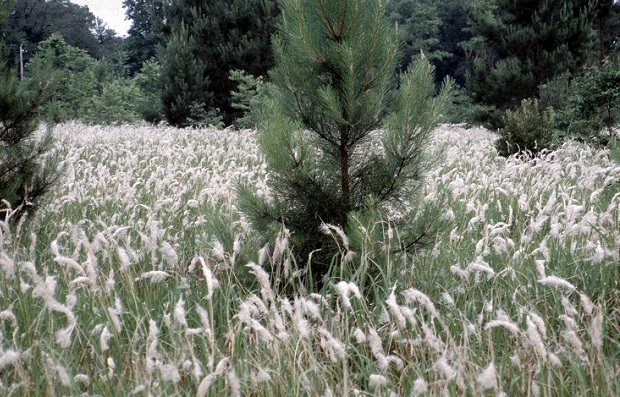Cogongrass
Cogongrass affects pine productivity and survival, wildlife habitat, recreation, native plants, fire behavior, site management costs, and more.

MS Cogongrass Information Guide, produced by the Mississippi Forestry Commission and Mississippi State University
About Cogongrass
Cogongrass (Imperata cylindrical) is an invasive, non-native grass that occurs in the Southeast region of the United States. It is considered an invasive species in 73 countries and one of the “Top 10 Worst Weeds in the World.” Cogongrass has several common names, including Japanese bloodgrass, Red Baron, or Speargrass.
Vegetative Growth
Cogongrass produces upright, smooth stems 6–47 inches tall that form loose or densely compacted stands. Its dense stems and rooting system choke out other vegetation. Leaves of cogongrass display a midrib that is off-set (closer to one leaf margin than the other).
Flowering
An unusual characteristic of cogongrass is its flowering pattern. It flowers immediately after the transition from dormancy to full greenup in the spring, typically from March to May, although warm winters may cause earlier greenup and flowering. Cogongrass can also flower following frost, fire, mowing, tillage, or other disturbances. Most native grasses that resemble cogongrass flower well after plants have turned green, rather than immediately after greenup. Flowers typically occur at the top of the stem and are easily identified by silvery or whitish, silky hairs attached to the seed that create the appearance of a feathery plume. Silver beardgrass [Bothriochloa saccharoides (Sw.) Rydb; Syn. Andropogon sacchariodes Sw.] can be confused with cogongrass. However, silver beardgrass is smaller, forms clumps rather than dense stands, and flowers in summer.
Each cogongrass plant can produce up to 3,000 seeds per season. Cross-pollination is necessary for seed production. Seedlings are frequently found in open sites that have been disturbed by clear-cutting, burning, tillage, excavation, grading, fire ant mounds, or other disturbances. Seedlings begin to produce rhizomes about 4 weeks after emergence.
Dispersal
Cogongrass is typically spread by wind, vehicles, equipment, animals, and contaminated soil.
Habitat
In the Midsouth and other southern states, cogongrass usually occurs in non-cultivated sites, including pastures, orchards, fallow fields, forests, parks, natural areas, and highways, electrical utility, pipeline, and railroad rights-of-way. Cogongrass prefers sandy soils with low nutrient levels, although it will inhabit more fertile sites.
Distribution
Cogongrass occurs as a weed in Alabama, Florida, Georgia, Louisiana, Mississippi, Oregon, South Carolina, Texas, and Virginia. Several thousand acres are infested with cogongrass in the southeastern United States; more than 1.2 billion acres are infested worldwide. Unfortunately, this weed continues to spread.
Control Methods
Chemical
Currently, there is no single treatment that effectively eliminates cogongrass infestations. The most commonly used herbicides to treat cogongrass are glyphosate and imazapyr. Repeated applications each year for several years are usually needed for control.
Glyphosate products (3 lb. ae/gal or 41% active ingredient formulations) such as Roundup Ultra or Roundup Pro at a rate of 5 pints per acre (broadcast) or as a 2% solution (spot treatment) will suppress cogongrass.
Imazapyr products (2 lb. ae/gal or a 28% active ingredient) such as Arsenal, Polaris, or Habitat at a rate of 48 ounces per acre (broadcast) or a 1% solution (spot treatment) can be used in certain areas and provide excellent control up to 1 year after application.
Imazapyr products (4 lb. ae/gal or a 53% active ingredient) such as Arsenal AC at a rate of 24 ounces per acre (broadcast) or a .5% solution (spot treatment) can be used in certain areas and provide excellent control up to 1 year after application.
Because glyphosate and imazapyr are nonselective, applications may damage nearby desirable vegetation. Since imazapyr remains in the soil for long periods, its effectiveness on cogongrass and other plants may continue up to a year after application. Do not apply imazapyr herbicides within two times the dripline of any desirable vegetation.
Mechanical
Cogongrass will not persist in areas frequently tilled; therefore, frequent tillage can control cogongrass in certain sites.
Physical
Mowing or burning will remove aboveground cogongrass vegetation, but these methods open the plant canopy for the emergence of seedlings and new stems from rhizomes.
Cultural
Broadcasting or drilling Roundup Ready soybeans into cogongrass, followed by glyphosate applications, has been a very effective control method.
Report a Sighting of Cogongrass
To report a sighting of this invasive grass, please call the Mississippi Department of Agriculture and Commerce – Bureau of Plant Industry at (662) 325-3390.
The Cogongrass Control Program
The Cogongrass Control Program aims to reduce the threat of cogongrass in relevant areas of the state. Applicants to the program may receive herbicide treatment for the affected areas of their property. All work will occur within the boundaries of the State of Mississippi.
Current guidelines for this program may not allow the MFC or its contractors to treat cogongrass within 150 feet of standing water (lakes, rivers, ponds).
Treatment of pasture where animals are actively grazing, or hay is to be cut also comes with some restrictions (explained in the Terms and Conditions document when applying).
One treatment is often not enough to completely and permanently eradicate cogongrass. This program aims to educate landowners about treating cogongrass and help them start down a path to sustainable control of it on their property.
Cogongrass Resources
- Cogongrass.org
- Field Guide to the Identification of Cogongrass (PDF)
- Plant Profile – USDA Natural Resource Conservation Service Plants Database
- MS Cogongrass Suppression Map
- Video: Cogongrass – One of the Top 10 Worst Weeds in the World by MFC
- Video: Cogongrass, the Perfect Weed developed and produced by the Coastal Plains RC&D Center
- Video: Cogongrass on Fire, filmed on location in Alabama
For more information about the Cogongrass Control Program, please contact:
